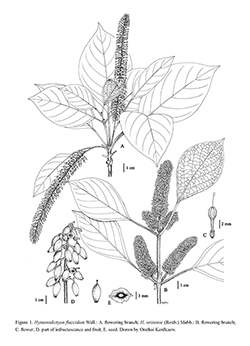e-Flora of Thailand
Volume 15 > Part 1 > Year 2021 > Page 16 > Rubiaceae > Hymenodictyon
2. Hymenodictyon orixense (Roxb.) Mabb.wfo-0000216107
Taxon 31: 66. 1982; Razafim. & B.Bremer, Bot. J. Linn. Soc. 152: 375. 2006; Tao Chen & C.M.Taylor in Z.Y.Wu et al., Fl. China 19: 176. 2011.— Cinchona orixensis Roxb., Med. Facts Observ. 6: 148. 1793. Fig. 1B–G.
Accepted Name : This is currently accepted.
Synonyms & Citations :
Description : Deciduous trees (5–)10–25 m tall (often leafless or almost so when fruiting), dbh to 35 cm; bark (grey-)brown, smooth to roughish. Stipules ovate to lanceolate, 1–.5 cm long, apex acuminate, glabrous to pubescent. Leaves ovate, oblong, elliptic or lanceolate, 10–25 by 5–15 cm, base acute to cuneate, apex acuminate, subcoriaceous to membranaceous, glabrous to puberulous above, pubescent to puberulous beneath, lateral veins 7–10 pairs; petiole 1.5–8 cm long, glabrous to puberulous. Inflorescences deflexed, (10–)15–25 cm long, consisting of terminal main raceme-like unit and, at its base, at least one pair of shorter, more compact lateral raceme-like units arising in axil of pair of long-petiolate pale green to greenish white leaf-like bracts; if more than one pair of lateral units present, each in axil of bract pairs; bracts ovate to (broadly) elliptic, 8–15 by 4–10 cm, glabrous to puberulous; peduncles 5–10 cm long. Calyx lobes oblong, 1–1.5 mm long, pubescent. Corolla pale greenish yellow to pale yellowish; tube abruptly widening above, 2.5–3.5 mm long; lobes oblong, 2–2.5 mm long, pubescent outside. Anthers 1–1.5 mm long. Ovary obovoid, ca 1 mm long, puberulous to pubescent; style with globose stigma exserted for 4–6 mm. Capsules ellipsoidal to broadly ovoidal, 1.2–1.8 cm long. Seeds 10–20 per locule, elliptic, 0.8–1.2 by 0.4–0.6 cm (including wings), broadly winged all around, shallowly fringed.
Thailand : NORTHERN: Mae Hong Son, Chiang Mai, Chiang Rai, Phrae, Tak, Kamphaeng Phet, Nakhon Sawan; NORTH-EASTERN: Loei, Nong Bua Lum Phu, Sakon Nakhon, Mukdahan, Kalasin, Khon Kaen; EASTERN: Nakhon Ratchasima, Ubon Ratchathani; SOUTH-WESTERN: Kanchanaburi; CENTRAL: Saraburi; SOUTH-EASTERN: Chon Buri, Sa Kaeo; PENINSULAR: Surat Thani, Phuket, Krabi, Trang, Satun (Tarutao).
Distribution : India (type), Sri Lanka, Bangladesh, Nepal, Myanmar (Upper), Laos, Cambodia, Vietnam, the Philippines.
Ecology : Mixed, drydeciduous forests, seldom in mixed dry evergreen forests, sometimes on exposed ridges, over granite, sandstone or limestone, 0–900 m alt. Flowering: April–June(–August); fruiting: August–January(–April).
Vernacular : Som kop (ส้มกบ)(Northern); lata (ลาตา)(Trang); lu (ลุ)(Surat Thani); som het (ส้มเห็ด)(Peninsular); som lu (ส้มลุ)(Surat Thani); u lok (อุโลก)(Ratchaburi); sang-ho (สังเหาะ)(Karen-Chiang Mai).
CommonName : Bridal couch tree.
Uses: Medicinally used.
Notes: 1. Growing in dry, deciduous, fire-prone habitats the plants are capable of re-sprouting after a fire. Such shoots, sometimes produced in groups, in habit, resemble shrubby forms of Hymenodictyon flaccidum.
2. Quite variable in indumentum. Also the extent of the inflorescence (number of paired lateral units) and the number of flowers per cluster (cyme) on the main and lateral inflorescence axes (few to many) and their density (clusters sometimes rather widely spaced) are variable.

